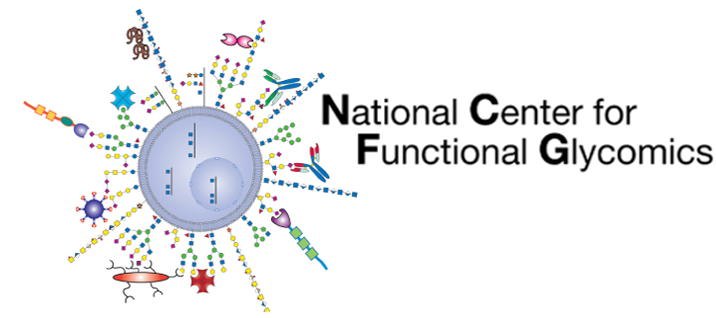By: Richard D. Cummings
A peptide is usually considered to be a linkage of 2 to 50 amino acids via peptide bonds, and proteins are larger than 50 or so amino acids. In animal cells, peptides and proteins are synthesized using a template of short or long mRNAs; if they are then modified with attached carbohydrates they are termed glycopeptides and glycoproteins, respectively. [Of course, a glycopeptide could also be generated from a glycoprotein by proteolysis.]
However, remarkably, some peptides and glycopeptides found in nature do not require an RNA template. Many of the best known such glycopeptides in nature are made by bacteria! For example, a very famous glycopeptide is the antibiotic vancomycin. It is a heptapeptide synthesized by the Gram-positive bacterium Amycolatopsis orientalis, using nonribosomal peptide synthetases (1) that do not require an RNA template (2). Vancomycin contains two sugars - glucose and an amino sugar named vancosamine, and these are added to the peptide by GtfE (glucosyltransferase) and GtfD (vancosaminyltransferase) using dTDP-sugar precursors (3). Interestingly, the total synthesis of vancomycin was recently reported (4,5). Vancomycin is sometimes considered as a drug of last resort, as it can be used to treat Gram-positive bacteria, such as methicillin-resistant Staphylococcus aureus (MRSA). Vancomycin is a potent antibiotic as it can inhibit assembly of peptidoglycan (6). The carbohydrate residues of vancomycin, as for the many dozens of glycopeptide antibiotics (7), are important for their functions and binding (8). Other glycopeptide antibiotics include teicoplanin, bleomycin, and ristocetin, and like vancomycin, they are broad spectrum antibiotics against Gram-positive pathogens. The generation of glycopeptides by bacteria is an ancient process, whose phylogenetic history is 150-400 million years old (9). Efforts are underway to modify the carbohydrates and other features in such glycopeptide antibiotics to enhance and diversify their effectiveness (10).
References:
- Miller, B. R., and Gulick, A. M. (2016) Structural Biology of Nonribosomal Peptide Synthetases. Methods Mol Biol 1401, 3-29
- Yim, G., Thaker, M. N., Koteva, K., and Wright, G. (2014) Glycopeptide antibiotic biosynthesis. J Antibiot (Tokyo) 67, 31-41
- Fu, X., Albermann, C., Jiang, J., Liao, J., Zhang, C., and Thorson, J. S. (2003) Antibiotic optimization via in vitro glycorandomization. Nat Biotechnol 21, 1467-1469
- Okano, A., Isley, N. A., and Boger, D. L. (2017) Total Syntheses of Vancomycin-Related Glycopeptide Antibiotics and Key Analogues. Chem Rev 117, 11952-11993
- Moore, M. J., Qu, S., Tan, C., Cai, Y., Mogi, Y., Jamin Keith, D., and Boger, D. L. (2020) Next-Generation Total Synthesis of Vancomycin. J Am Chem Soc 142, 16039-16050
- Kahne, D., Leimkuhler, C., Lu, W., and Walsh, C. (2005) Glycopeptide and lipoglycopeptide antibiotics. Chem Rev 105, 425-448
- Blaskovich, M. A. T., Hansford, K. A., Butler, M. S., Jia, Z., Mark, A. E., and Cooper, M. A. (2018) Developments in Glycopeptide Antibiotics. ACS Infect Dis 4, 715-735
- Kren, V., and Rezanka, T. (2008) Sweet antibiotics - the role of glycosidic residues in antibiotic and antitumor activity and their randomization. FEMS Microbiol Rev 32, 858-889
- Waglechner, N., McArthur, A. G., and Wright, G. D. (2019) Phylogenetic reconciliation reveals the natural history of glycopeptide antibiotic biosynthesis and resistance. Nat Microbiol 4, 1862-1871
- Marschall, E., Cryle, M. J., and Tailhades, J. (2019) Biological, chemical, and biochemical strategies for modifying glycopeptide antibiotics. J Biol Chem 294, 18769-18783
